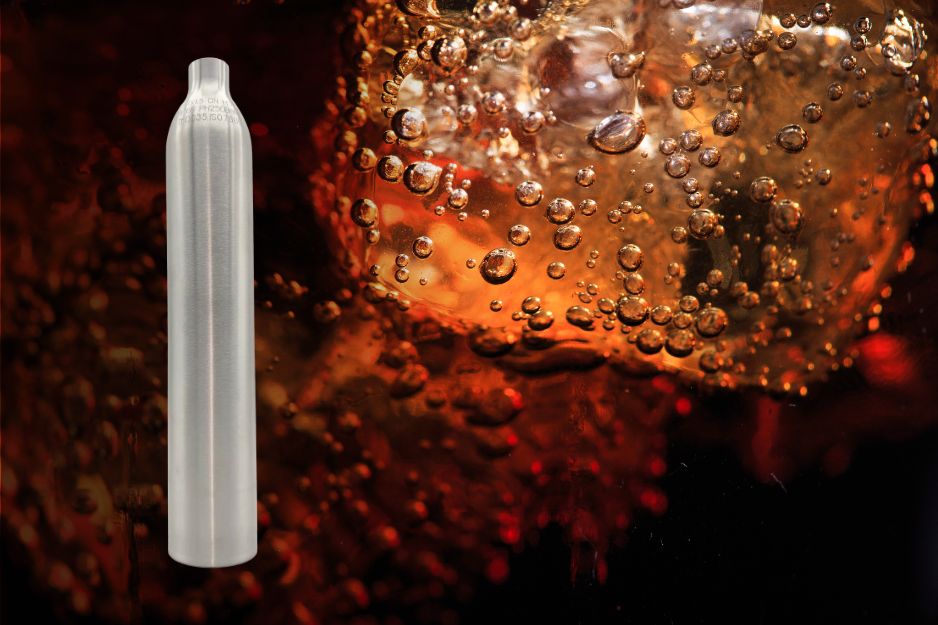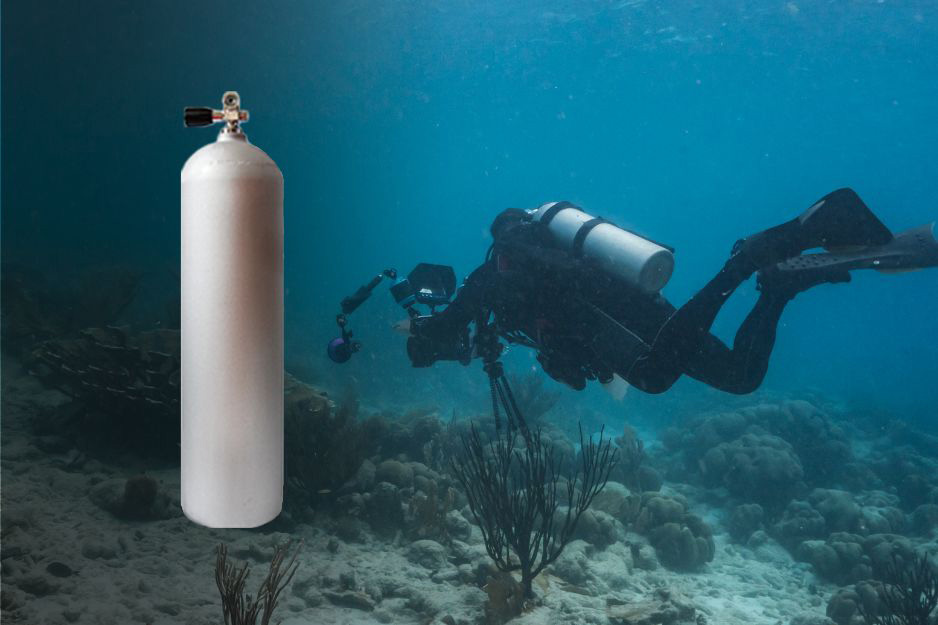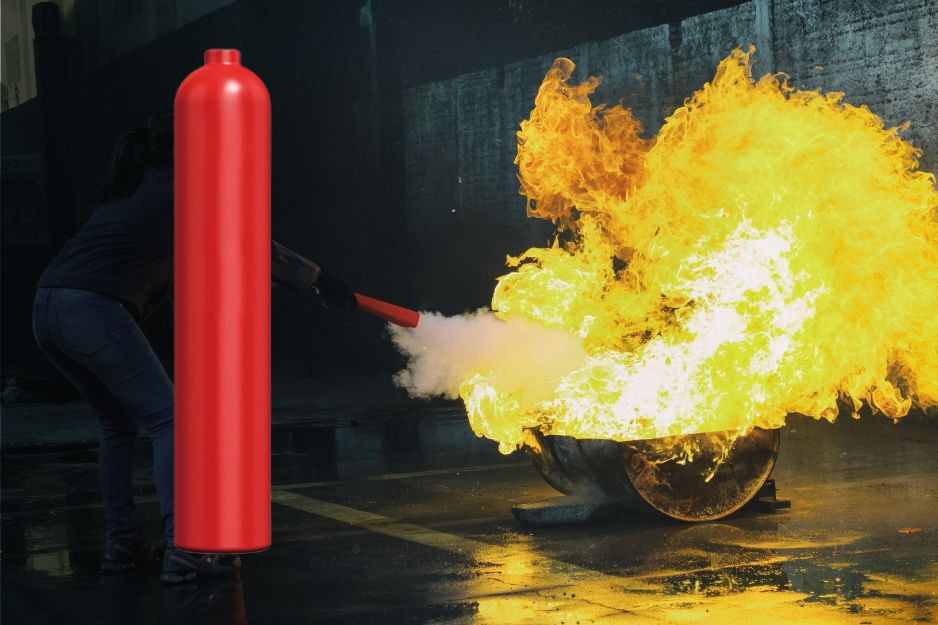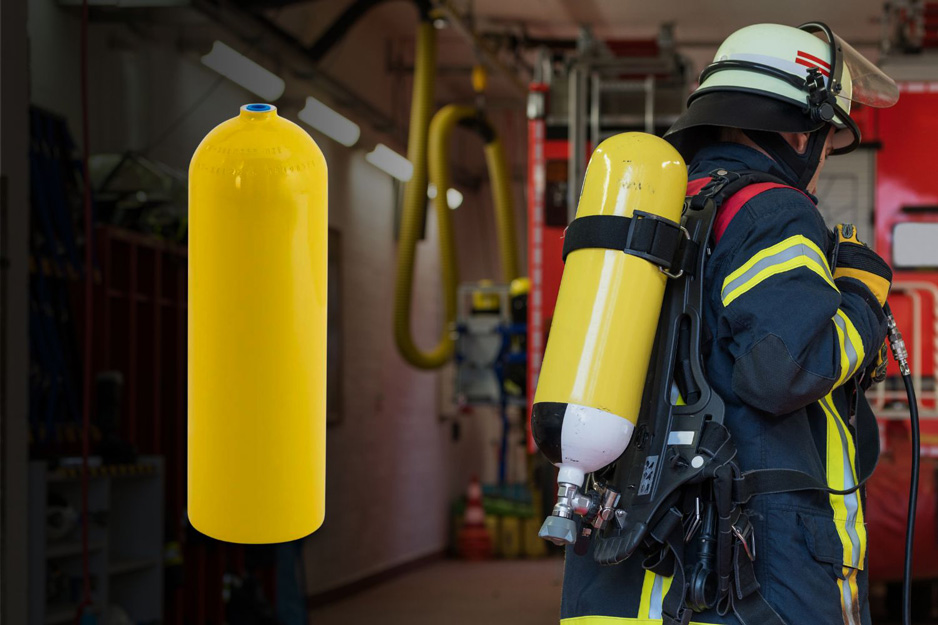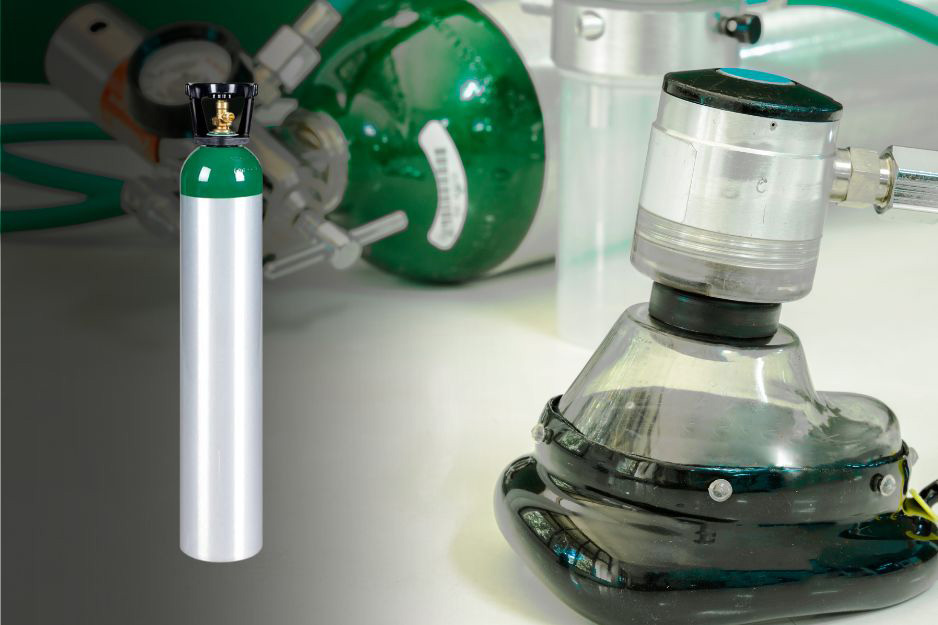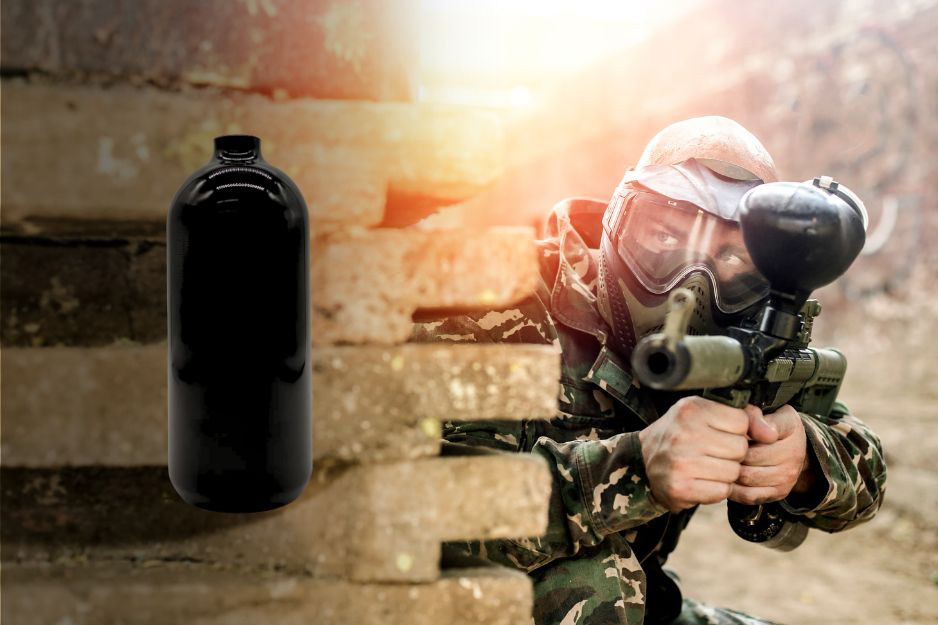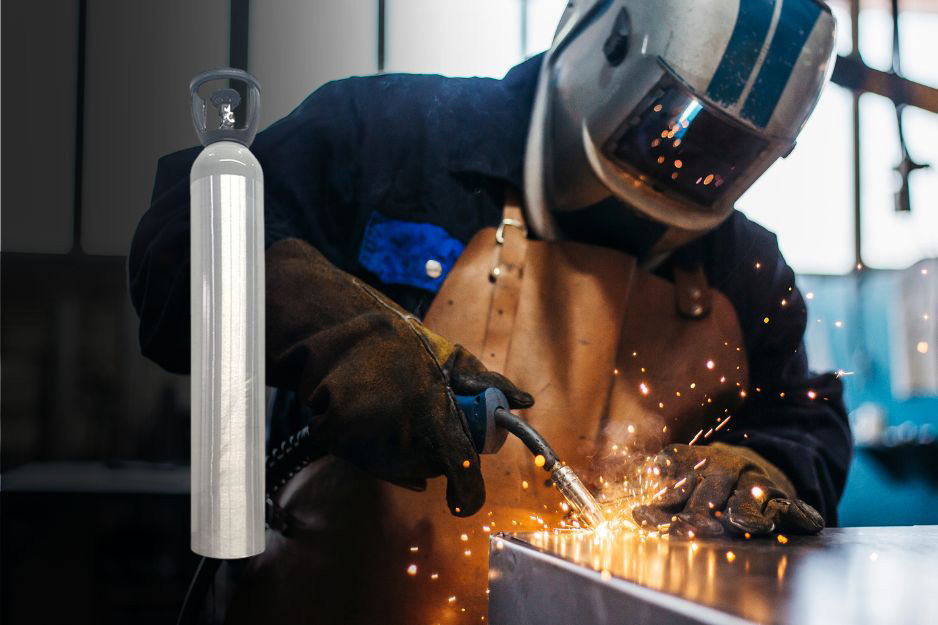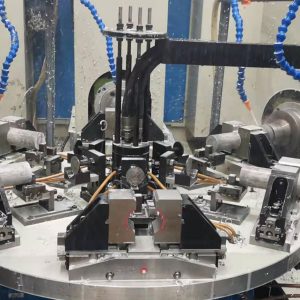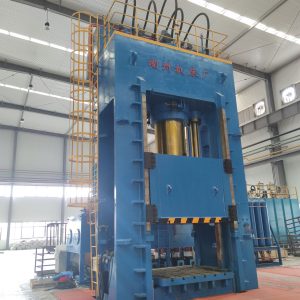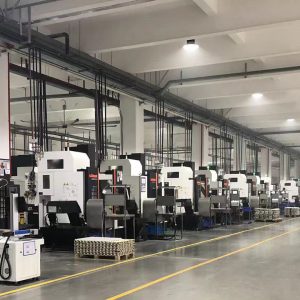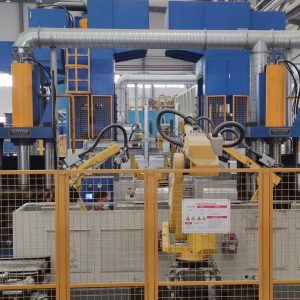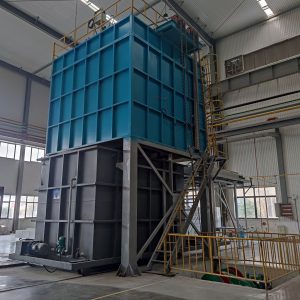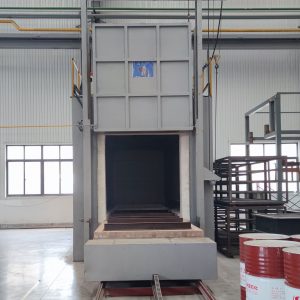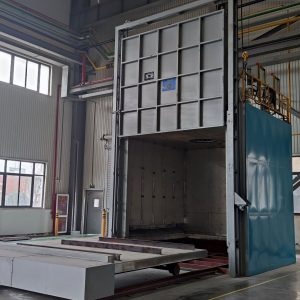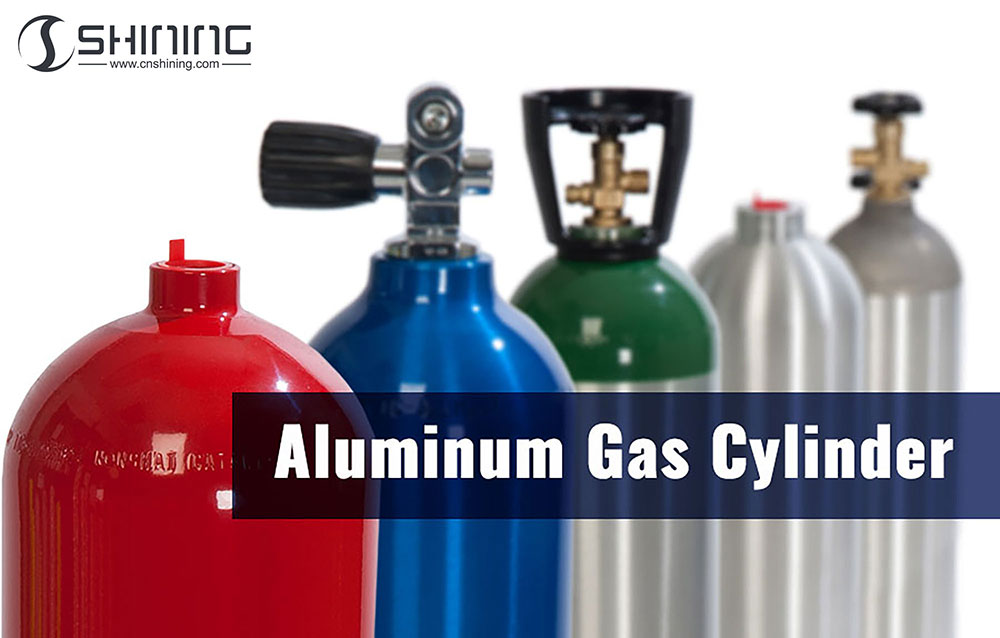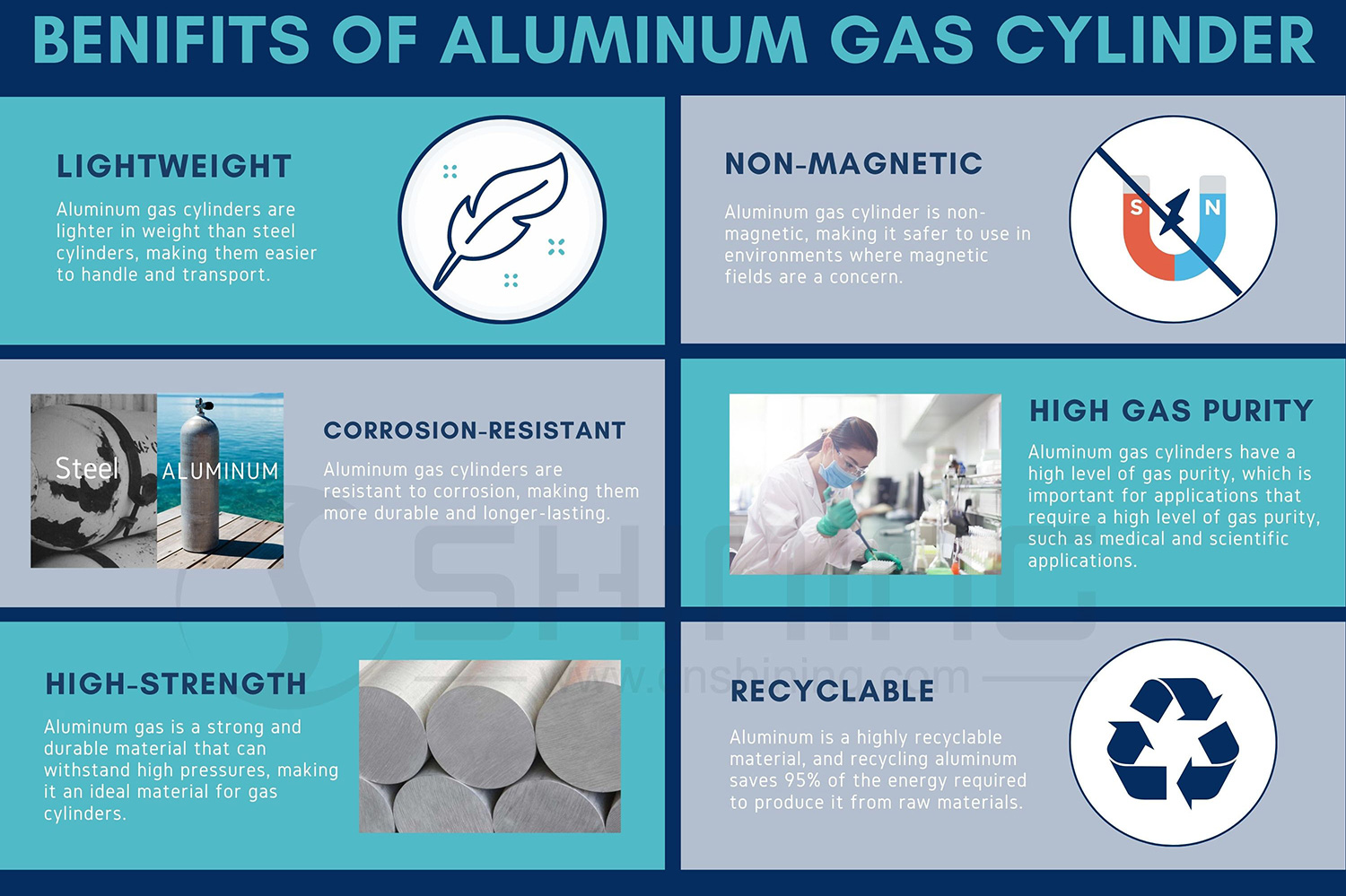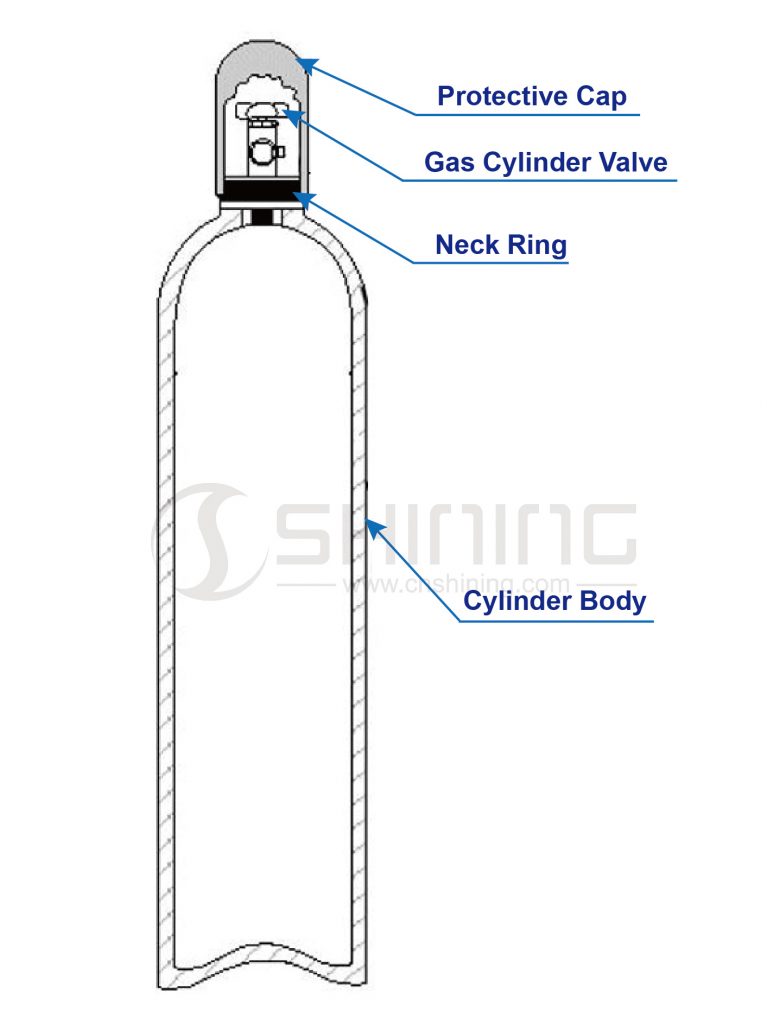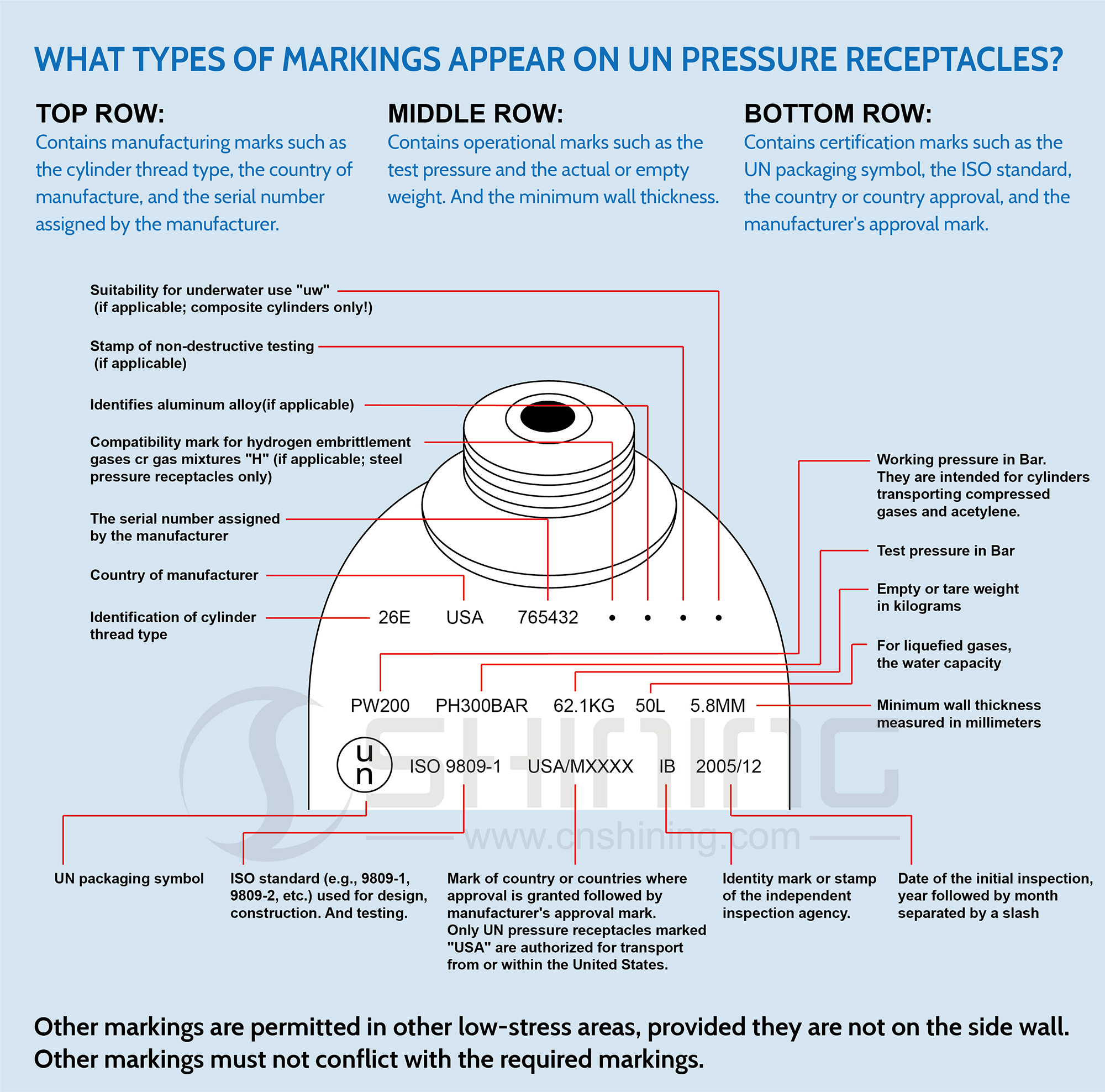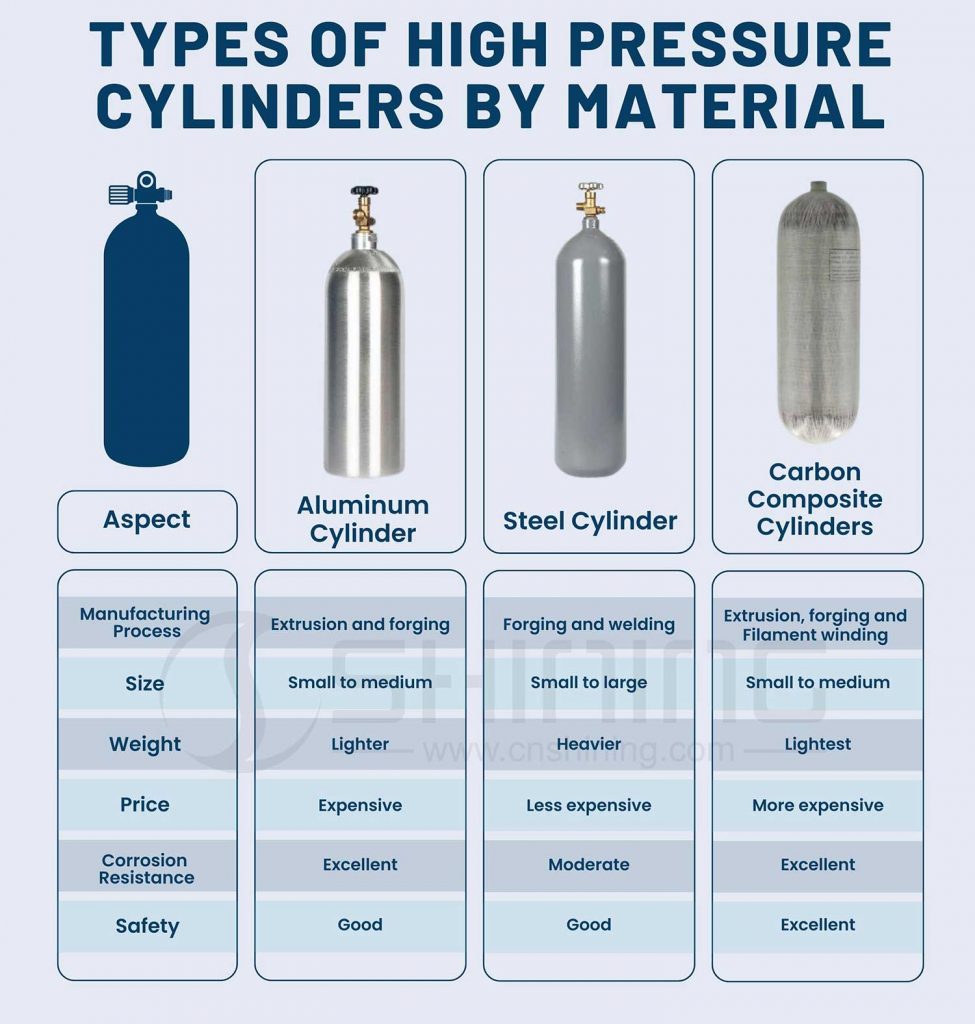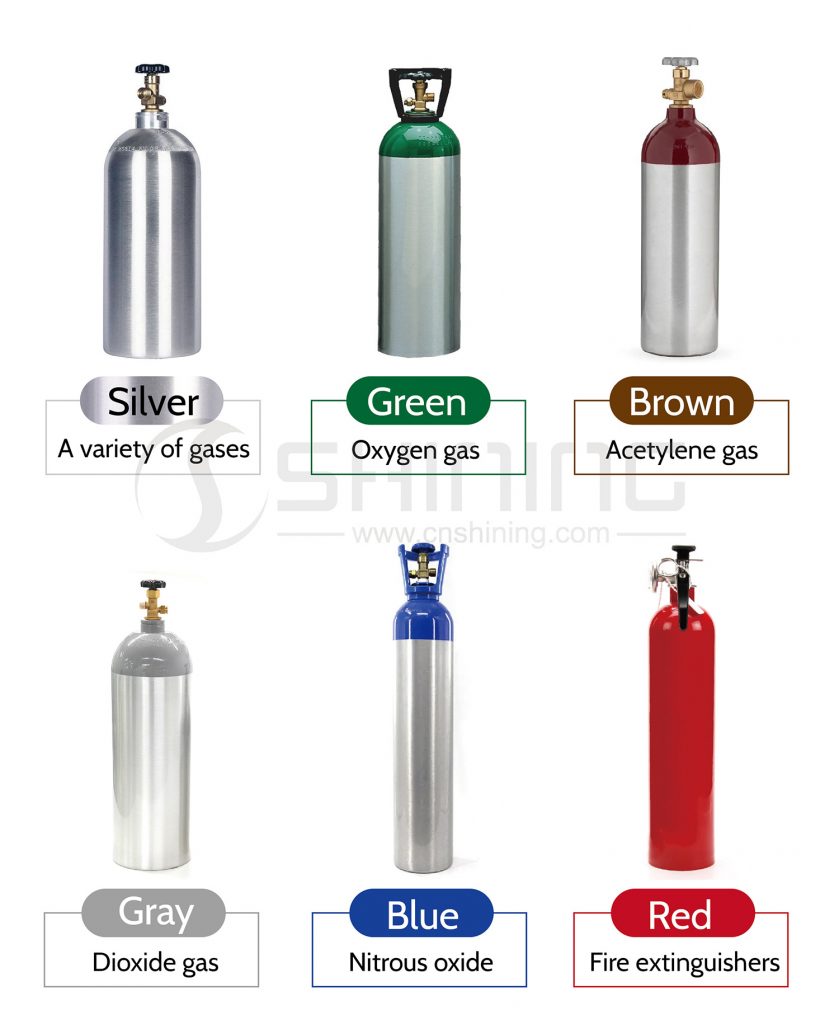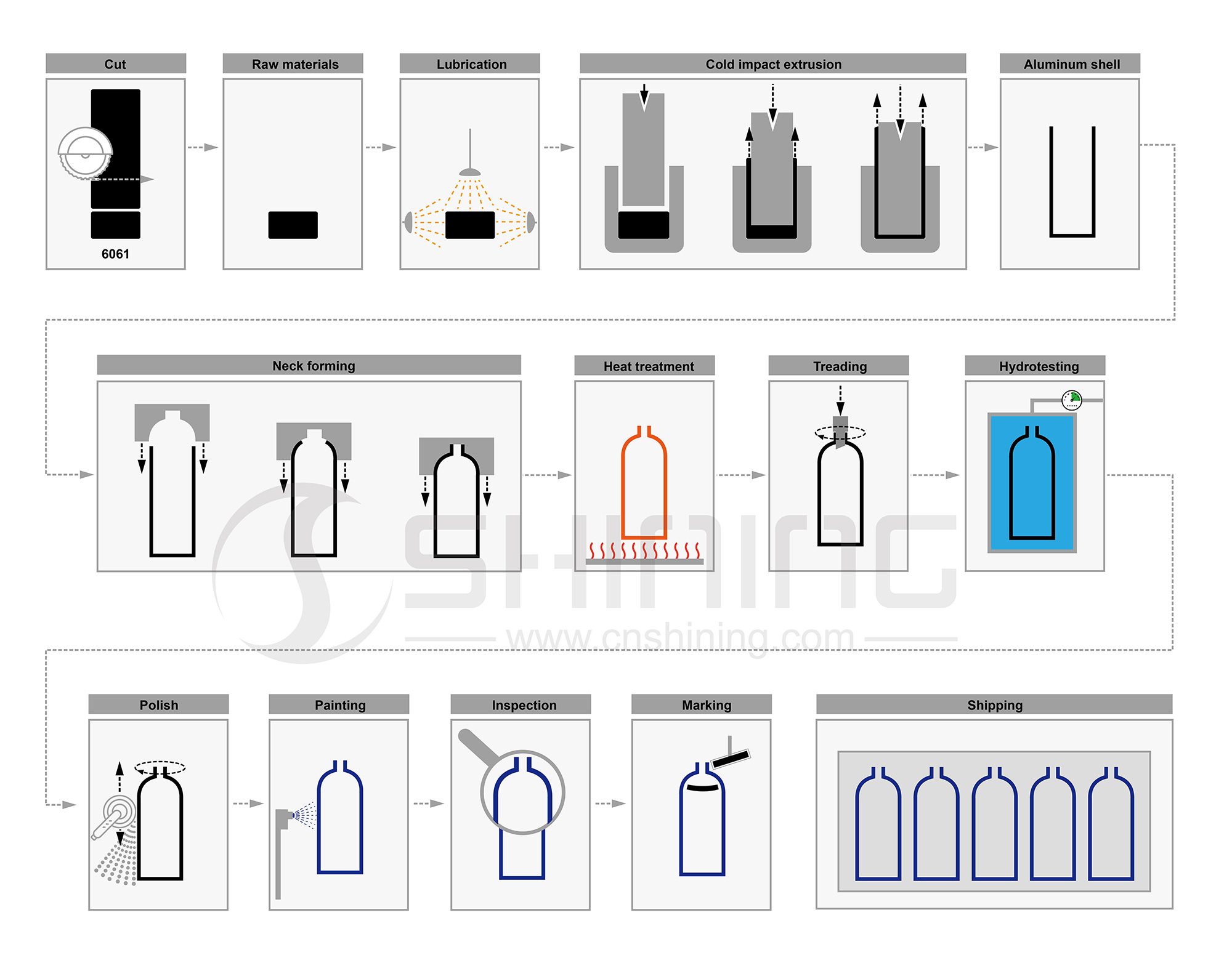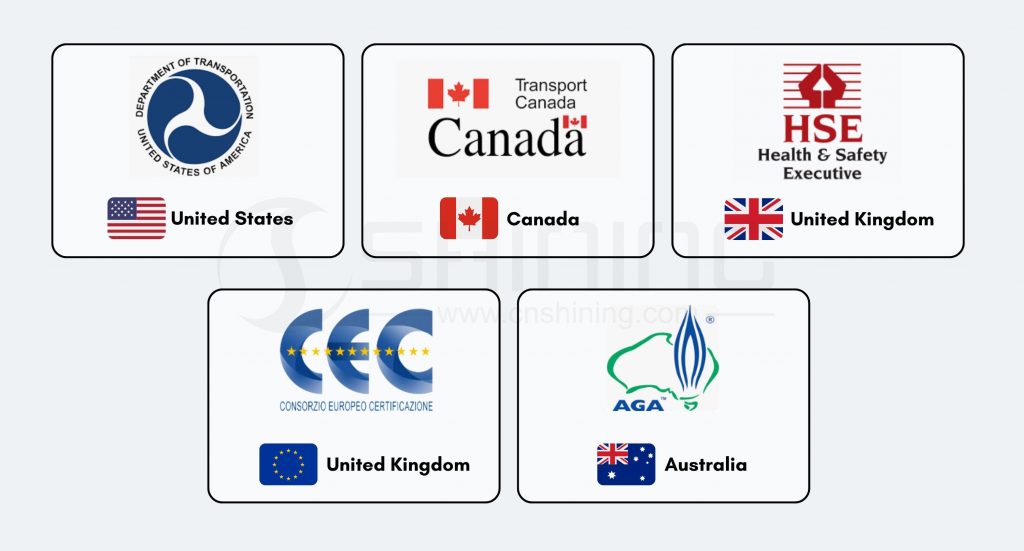샤이닝 알루미늄 패키징은 중국 내 고압 가스 실린더의 선도적 공급업체입니다. 당사는 2001년부터 실린더 연구 개발에 기부하여 음료, 스쿠버, 의료, 방화 및 특수 산업을 위한 우수한 품질의 제품을 제공하고자 합니다.
알루미늄 가스 실린더 제조업체
장비
당사의 품질관리는 ISO, DOT, TPED 등의 국제 기준을 엄격히 준수하여 보장되며, 당사는 고객의 요구 사항 및 기대와 국제 기준을 충족하거나 초과하기 위해 ISO9001에 따른 첨단 자동 기계 및 생산 시스템을 갖추고 있습니다.
사용후기
귀하의 서비스와 인쇄 및 알루미늄 제품의 우수한 품질에 진심으로 감사드리며, 귀하를 알루미늄 포장이 포함된 새로운 프로젝트의 참조 공급업체로 생각합니다.
와파 할룸 프로젝트 책임자
당신은 우리의 훌륭한 파트너였으며 이 가장 특이한 시기에 추가적인 유연성이 필요하다는 점을 이해하시기 바랍니다.
크리스 토우정답게 소곤 거리다
이전의
다음
찾고 있습니다 알루미늄 가스 실린더?
알루미늄 가스 실린더에 대한 완벽한 가이드
1. 소개
1.1 알루미늄 가스 실린더의 정의
알루미늄 가스 실린더는 산소, 질소, 헬륨, 이산화탄소와 같은 압축 가스를 저장하고 운반하도록 설계된 6061 알루미늄으로 만든 용기입니다. 이러한 실린더는 일반적으로 휴대 가능하고 가벼운 압축 가스 공급원이 필요한 다양한 산업 및 의료 분야에서 사용됩니다.
알루미늄 가스 실린더는 강철 실린더에 비해 여러 가지 장점을 제공하는데, 여기에는 더 가벼운 무게가 있어 휴대성이 더 좋고, 더 나은 내식성이 있어 수명을 연장하는 데 도움이 될 수 있습니다. 또한 알루미늄 실린더는 열전도도가 더 높아 가스 충전 및 배출 중에 더 효율적인 열 발산이 가능합니다. 그러나 알루미늄 실린더는 제조에 사용되는 재료 비용이 더 높기 때문에 강철 실린더보다 비쌀 수 있습니다.
1.2 알루미늄 가스 실린더 역사
알루미늄 가스 실린더의 역사는 20세기 초로 거슬러 올라갈 수 있는데, 그때 알루미늄이 고압 용기 제작에 적합한 소재로 처음 발견되었습니다. 알루미늄을 사용하기 전에 가스 실린더는 일반적으로 강철이나 철로 만들어졌는데, 이는 무겁고 녹슬기 쉬웠습니다.
1920년대에 독일 회사 Mannesmann은 신생 항공 산업을 위해 알루미늄 가스 실린더를 생산하기 시작했습니다. 이 실린더는 원래 항공기 공압 시스템에서 압축 공기를 저장하는 데 사용되었습니다. 강철 실린더보다 가벼워서 무게가 중요한 요소인 항공기에서 사용하기에 적합했습니다.
알루미늄 가스통은 1940년대와 1950년대에 용접, 다이빙, 의료용 산소 저장을 포함한 다양한 용도로 더 널리 사용되기 시작했습니다. 이러한 실린더는 일반적으로 가볍고 고강도의 용기를 생산하는 매끄러운 압출 공정을 사용하여 만들어졌습니다.
시간이 지남에 따라 알루미늄 가스 실린더의 디자인은 재료, 제조 공정 및 안전 기준이 개선되면서 진화했습니다. 오늘날 알루미늄 가스 실린더는 의료, 산업 및 레저 분야를 포함한 다양한 응용 분야에 사용됩니다. 가볍고 내구성이 뛰어나며 부식에 대한 저항성이 뛰어나 많은 현대 기술의 중요한 구성 요소입니다.
1.3 알루미늄 가스 실린더의 이점
알루미늄 가스 실린더를 사용하는 데는 다음과 같은 여러 가지 이점이 있습니다.
- 경량: 알루미늄 가스 실린더는 강철 실린더보다 무게가 가벼워서 취급 및 운반이 더 쉽습니다.
- 부식 방지 기능: 알루미늄 가스 실린더는 부식 방지 기능이 뛰어나 내구성이 뛰어나며 수명이 더 깁니다.
- 고강도: 알루미늄 가스는 고압을 견딜 수 있는 강하고 내구성 있는 소재로 가스 실린더에 이상적입니다.
- 비자성: 알루미늄 가스 실린더는 비자성이므로 자기장이 문제가 되는 환경에서 사용하기가 더 안전합니다.
- 높은 가스 순도: 알루미늄 가스 실린더는 높은 수준의 가스 순도를 갖고 있어 의료 및 과학 분야와 같이 높은 수준의 가스 순도가 요구되는 분야에 필수적입니다.
- 재활용 가능: 알루미늄은 재활용성이 매우 높은 소재이며, 알루미늄을 재활용하면 원료에서 생산하는 데 필요한 에너지의 95%를 절약할 수 있습니다. 즉, 알루미늄 가스통은 반복적으로 재활용할 수 있어 폐기물을 줄이고 천연자원을 보존할 수 있습니다.
2. 알루미늄 가스 실린더 구조
알루미늄 가스 실린더는 일반적으로 가볍고 내구성 있는 구조를 제공하는 고강도 알루미늄 합금으로 만들어집니다. 실린더의 특정 디자인은 의도된 용도에 따라 다를 수 있지만 대부분의 알루미늄 가스 실린더는 유사한 기본 구조를 가지고 있습니다.
알루미늄 가스 실린더의 주요 구성 요소는 다음과 같습니다.
실린더 본체: 이것은 실린더의 주요 부분이며 일반적으로 원통형입니다. 본체는 고압을 견디도록 설계된 이음매 없는 압출 알루미늄 합금 튜브로 만들어졌습니다. 실린더의 압력 정격은 실린더 벽의 두께를 결정합니다.
목걸이: 이것은 실린더 본체의 상단에 있는 칼라입니다. 넥 링은 밸브에 대한 안전한 부착 지점을 제공하고 취급 및 운송 중에 실린더가 손상되지 않도록 보호합니다. 넥 링은 일반적으로 나사산이 알루미늄 가스 실린더의 벽 두께를 줄이기 때문에 나사산이 아닌 리벳으로 고정됩니다.
가스 실린더 밸브: 가스 실린더 밸브는 가스 실린더의 가스 흐름을 제어하는 장치입니다. 일반적으로 황동이나 강철로 만들어지며 내구성이 뛰어나고 고압에 강하도록 설계되었습니다. 밸브는 일반적으로 나사산 연결을 사용하여 알루미늄 실린더에 연결되며 밸브 휠이나 핸들을 사용하여 열거나 닫을 수 있습니다. 가스 실린더 밸브는 안전하고 신뢰할 수 있도록 설계되었으며 일반적으로 몇 가지 내장형 안전 기능이 있습니다. 예를 들어, 많은 밸브에는 실린더 내부의 압력이 특정 수준을 초과하면 자동으로 가스를 배출하는 압력 방출 장치가 있습니다. 이는 실린더가 폭발하거나 파열되는 것을 방지하는 데 도움이 됩니다.
보호 캡: 보호 캡은 실린더를 사용하지 않을 때 밸브를 손상 및 오염으로부터 보호하기 위해 밸브 위에 씌우는 플라스틱 또는 금속 덮개입니다.
전반적으로 알루미늄 가스 실린더의 설계는 고압 가스를 안전하게 담을 수 있는 견고하고 가볍고 내구성 있는 구조를 제공하는 데 중점을 두고 있습니다. 실린더의 특정 구성 요소와 기능은 의도된 용도와 애플리케이션 요구 사항에 따라 달라집니다.
3. 알루미늄 가스 실린더 표시
알루미늄 가스 실린더는 교통부(DOT)와 캐나다 교통부(TC)가 정한 규정에 따라 표시해야 합니다. 표시는 실린더의 내용물, 사용법 및 안전에 대한 필수 정보를 제공합니다.
알루미늄 가스 실린더에서 볼 수 있는 몇 가지 표준 표시는 다음과 같습니다.
맨 위 줄: 실린더 나사 유형, 제조 국가, 제조업체에서 지정한 일련 번호 등의 제조 표시가 포함되어 있습니다.
- 수중 사용에 적합(해당되는 경우 "uw"); 합성 실린더만 해당!
- 비파괴 검사 스탬프(해당되는 경우)
- 알루미늄 합금을 식별합니다(해당되는 경우).
- 수소 취성 가스 CR 가스 혼합물에 대한 호환성 표시 “H”(해당되는 경우; 강철 압력 용기만 해당)
- 제조업체에서 할당한 일련 번호
- 제조국
- 실린더 나사 유형 식별
가운데 줄: 시험 압력 및 실제 또는 공허 중량과 같은 작동 마크를 포함합니다. 그리고 최소 벽 두께.
- 작동 압력(Bar). 압축 가스와 아세틸렌을 운반하는 실린더에 적합합니다.
- Bar 단위의 시험 압력
- 공허 중량 또는 순중량(kg)
- 액화가스의 경우 물의 용량
- 최소 벽 두께는 밀리미터로 측정
맨 아래 줄: UN 포장 기호, ISO 표준, 국가 또는 국가 승인, 제조업체 승인 마크와 같은 인증 마크가 포함되어 있습니다.
- UN 포장 기호
- 설계, 건설 및 테스트에 사용되는 ISO 표준(예: 9809-1, 9809-2 등).
- 승인이 부여된 국가 또는 국가들의 마크 뒤에 제조업체의 승인 마크가 붙습니다. "USA"로 표시된 UN 압력 용기만 미국에서 또는 미국 내에서 운송이 허가됩니다.
- 독립적인 검사 기관의 식별 표시 또는 스탬프.
- 최초 검사 날짜(년, 월)를 슬래시로 구분하여 입력
4. 재료별 고압 실린더 유형
강철 실린더, 알루미늄 실린더, 합성 실린더는 다양한 가스를 저장하고 운반하는 데 사용되는 다양한 고압 실린더입니다.
강철 실린더 가장 일반적인 유형의 가스 실린더로, 보통 이음매 없는 탄소강으로 만들어집니다. 내구성이 뛰어나고 고압을 견딜 수 있어 다양한 가스를 보관하고 운반하는 데 적합합니다. 강철 실린더는 비교적 저렴하고 여러 번 재사용할 수 있습니다. 그러나 무겁고 올바르게 유지 관리하지 않으면 부식되기 쉽습니다.
알루미늄 실린더 강철 실린더보다 가벼운 대안입니다. 고강도 알루미늄 합금으로 만들어졌으며 강철 실린더보다 부식 방지성이 뛰어납니다. 알루미늄 실린더는 강철 실린더보다 비싸지만 가볍고 부식 방지 특성으로 인해 스쿠버 다이빙 및 의료용 산소와 같은 특정 응용 분야에서 인기가 있습니다.
탄소섬유 복합재 실린더 얇은 벽의 알루미늄 합금 내부 실린더를 채택하고 탄소 섬유 복합 재료로 감았습니다. 강철 및 알루미늄 실린더보다 가볍고 강도와 내구성이 뛰어납니다. 복합 실린더는 또한 부식에 매우 강하고 산소, 질소 및 이산화탄소를 포함한 광범위한 가스를 저장할 수 있습니다. 그러나 강철 및 알루미늄 실린더보다 비쌉니다.
요약하자면, 각 실린더 유형은 고유한 장단점을 가지고 있으며, 어떤 유형을 사용할 것인지는 응용 프로그램의 특정 요구 사항에 따라 달라집니다.
5. 알루미늄 가스 실린더의 색상
알루미늄 가스 실린더는 용도나 산업에 따라 다양한 색상으로 나올 수 있습니다. 알루미늄 가스 실린더의 가장 일반적인 색상은 금속의 자연스러운 색상인 은색입니다. 그러나 제조업체는 식별이나 안전 목적으로 페인트나 분체 코팅을 사용하여 실린더에 다른 색상을 적용할 수도 있습니다.
가스 실린더의 색상 코딩은 안전한 취급, 보관 및 운송을 보장하기 위해 종종 산업 표준에 따라 표준화됩니다. 예를 들어, 미국에서는 압축 가스 협회(CGA)가 가스 실린더 숄더 마킹과 밸브 보호 캡에 대한 색상 코딩 시스템을 구축했습니다. 이 시스템은 특정 색상을 사용하여 가스 유형, 위험 수준 및 기타 중요한 정보를 나타냅니다.
- 은: 알루미늄 가스 실린더의 가장 일반적인 색상은 은색으로, 금속의 자연스러운 색상입니다. 이 실린더는 다양한 가스에 사용될 수 있으며 일반적으로 특정 유형의 가스에 지정되지 않습니다.
- 녹색: 녹색 실린더는 종종 산소 가스에 사용됩니다. 산소는 식물 생명에 필수적이며 녹색은 자연과 성장과 관련이 있기 때문입니다.
- 갈색: 갈색 실린더는 일반적으로 용접 및 절단 작업에 사용되는 아세틸렌 가스에 사용됩니다. 이 색상은 때때로 다른 가연성 가스에도 사용됩니다.
- 회색: 회색 실린더는 이산화탄소 가스에 자주 사용되며, 탄산음료와 맥주 등 식품 및 음료 분야에 일반적으로 사용됩니다.
- 파란색: 파란색 실린더는 종종 아산화질소에 사용됩니다. 이 색상은 때때로 다른 불연성 가스에도 사용됩니다.
- 빨간색: 붉은색 실린더는 종종 소화기에 사용되며, 이는 화재를 진압하는 데 사용되는 압축 가스를 담고 있습니다. 이 색상은 때때로 다른 유형의 압축 가스에도 사용됩니다.
실린더의 색상은 제조업체에 따라 다를 수 있으며 가스를 식별하는 데 사용되는 색상 코딩 시스템은 지역이나 국가에 따라 다를 수 있다는 점에 유의하는 것이 중요합니다. 따라서 항상 실린더 라벨을 참조하거나 숙련된 전문가와 상의하여 가스 실린더를 올바르게 식별하는 것이 필수적입니다.
6. 알루미늄 가스 실린더 밸브 연결 피팅 어댑터 유형
CGA(압축 가스 협회) 및 DIN(Deutsches Institut für Normung)은 가스 실린더 피팅에 대한 두 가지 표준입니다.
미국 표준: CGA
CGA 피팅은 북미에서 일반적으로 사용되며 번호 시스템(예: CGA 320, CGA 580)으로 식별됩니다. 이러한 피팅은 적절한 가스 실린더 밸브에 연결되도록 설계된 특정 치수와 나사산을 가지고 있습니다. 일부 표준 CGA 피팅은 다음과 같습니다.
- CGA 320 : 이산화탄소 및 기타 불활성 가스에 사용됨
- CGA 580 : 압축 공기 및 질소에 사용
- CGA 540 : 산소에 사용
- CGA 870 : 의료용 산소에 사용
- CGA 510 : 아세틸렌에 사용
- CGA 590 : 아르곤에 사용
- CGA 180 : 헬륨에 사용됨
- CGA 200 : 질소에 사용
- CGA 326 : 아산화질소에 사용
유럽 표준: DIN 477
DIN 피팅은 유럽에서 일반적으로 사용되며 DIN 번호(예: DIN 477-1, DIN 477-5)로 식별됩니다. 이러한 피팅은 또한 적절한 가스 실린더 밸브에 연결되도록 설계된 특정 치수와 나사산을 가지고 있습니다. 일부 표준 DIN 피팅은 다음과 같습니다.
- DIN 477-1: 질소 및 아르곤에 사용됨
- DIN 477-5: 이산화탄소에 사용됨
- DIN 477-6: 산소에 사용됨
- DIN 477-7: 프로판 및 부탄에 사용됨
- DIN 477-8: 수소에 사용됨
- DIN 477-9: 헬륨에 사용됨
- DIN 477-10: 아세틸렌에 사용됨
CGA 피팅이 있는 가스 실린더를 DIN 피팅이 필요한 시스템에 연결해야 하는 경우(또는 그 반대의 경우), 피팅 어댑터를 사용할 수 있습니다. DIN 어댑터는 다양한 CGA 피팅에 사용할 수 있으며, CGA 어댑터는 다양한 DIN 피팅에 사용할 수 있습니다.
영국 표준: BS341
가스 실린더 밸브 연결에 대한 영국 표준 사양 BS341은 가스 실린더에 사용되는 다양한 유형의 밸브 연결을 정의합니다. 다음은 BS341에서 지정한 다양한 유형의 연결입니다.
- BS 341 No. 2 – 이 연결은 부탄과 프로판 가스에 사용되며 21.7mm 밸브로도 알려져 있습니다.
- BS 341 No. 3 – 이 연결은 액화석유가스(LPG)에 사용되며 25mm 밸브라고도 합니다.
- BS 341 No. 4 – 이 연결은 아세틸렌 가스에 사용되며 9/16″ 밸브로도 알려져 있습니다.
- BS 341 No. 6 – 이 연결은 3/4″ 밸브라고도 하는 산소 가스에 사용됩니다.
- BS 341 No. 8 – 이 연결은 이산화탄소 가스, 즉 5/8″ 밸브에 사용됩니다.
- BS 341 No. 10 – 이 연결은 질소 가스에 사용되며 1 1/8″ 밸브라고도 합니다.
- BS 341 No. 13 – 이 연결은 아르곤 가스, 즉 5/8″ 밸브에 사용됩니다.
실린더 밸브 배출구 및 연결부
BS, CGA 및 DIN 표준 출구 연결부가 있는 밸브가 있는 가스 실린더. 어떤 경우에는 대체 연결이 사용될 수 있으며, 고객의 요청에 따라 아래에 표시된 표준 대신 제공됩니다.
| 가스 | 학사 | CGA | 소음 | 가스 | 학사 | CGA | 소음 |
| 아세틸렌 | 2 | 510 | – | 염화수소 | 6 | 330 | 8 |
| 공기 | 3 | 590 | 6 | 황화수소 | 15 | 330 | 5 |
| 알렌 | – | 510 | 1 | 이소부탄 | 4 | 510 | 1 |
| 암모니아, 무수 | 10 | 240, 660 | 8 | 이소부틸렌 | 4 | 510 | 1 |
| 아르곤 | 3 | 580 | 10 | 크립톤 | 3 | 580 | 10 |
| 아르신 | 4 | 350 | 5 | 메탄 | 4 | 350 | 1 |
| 1,3-부타디엔 | 4 | 510 | 1 | 염화메틸 | 7 | 660 | 5 |
| 부탄 | 4 | 510 | 1 | 메틸 메르캅탄 | – | 330 | 5 |
| 부텐 | 4 | 510 | 1 | 모노에틸아민 | 11 | 240 | 5 |
| 이산화탄소 | 8 | 320 | 6 | 모노메틸아민 | 11 | 240 | 5 |
| 일산화탄소 | 4 | 350 | 5 | 천연 가스 | 4 | 350 | 1 |
| 카르보닐 플루오라이드 | – | 660 | 8 | 네온 | 3 | 580 | 10 |
| 카르보닐 설파이드 | – | 330 | 5 | 산화질소 | 14 | 660 | 8 |
| 염소 | 6 | 660 | 8 | 질소 | 3 | 580 | 10 |
| 시안 | – | 660 | 8 | 이산화질소 | 14 | 660 | 8 |
| 중수소 | 4 | 350 | 1 | 아산화질소 | 13 | 326 | 6 |
| 디메틸아민 | 11 | 240 | 5 | 산소 | 3 | 540 | – |
| 디메틸 에테르 | – | 510 | 1 | 독가스 | 6 | 660 | 8 |
| 에탄 | 4 | 350 | 1 | 포스핀 | 4 | 350 | 5 |
| 에틸 아세틸렌 | – | 510 | 1 | 프로판 | 4 | 510 | 1 |
| 염화에틸 | 7 | 510 | 1 | 프로필렌 | 4 | 510 | 1 |
| 에틸렌 | 4 | 350 | 1 | 실란 | – | 350 | 5 |
| 산화 에틸렌 | 7 | 510 | 1 | 사불화규소 | – | 330 | 8 |
| 할로카본-14 | 6 | 580 | 6 | 이산화황 | 12 | 660 | 8 |
| 할로카본-22 | 6 | 660 | 6 | 육불화황 | 6 | 590 | 6 |
| 헬륨 | 3 | 580 | 10 | 트리메틸아민 | 11 | 240 | 5 |
| 수소 | 4 | 350 | 1 | 염화비닐 | 7 | 510 | 5 |
| 브롬화수소 | – | 330 | 8 | 기호 엑스 에 | 3 | 580 | 10 |
| 염화수소 | 6 | 330 | 8 |
7. 알루미늄 가스통의 제조
다음은 알루미늄 가스 실린더의 제조 공정과 관련된 단계에 대한 개요입니다.
원료: 알루미늄 가스 실린더 제조에 사용되는 주요 원료는 6061 합금으로 만든 알루미늄 슬러그입니다. 슬러그는 결국 실린더 본체를 형성하게 될 원통형 금속 조각입니다.
매끄럽게 하기: 슬러그는 제조 공정 중 마찰을 줄이기 위해 윤활됩니다. 이는 압출 중에 슬러그가 다이에 달라붙는 것을 방지하는 데 도움이 됩니다.
냉간 충격 압출: 그런 다음 윤활 처리된 슬러그를 다이에 넣고 냉간 충격 압출합니다. 이 프로세스는 원통형 쉘을 형성하기 위해 고압 하에서 슬러그를 압축하는 것을 포함합니다.
목 형성: 셸이 형성된 후 밸브가 부착될 목을 만들기 위해 상단 끝이 형성되고 형성됩니다.
열처리: 쉘은 강도와 경도를 높이기 위해 담금질을 포함하는 열처리를 받습니다. 그런 다음 쉘은 원하는 강도와 내구성을 얻기 위해 T6 용체화 처리로에서 숙성됩니다.
트레딩: 셸은 상단 끝에 나사산이 있어 밸브 부착이 가능합니다.
수압 테스트: 그런 다음 실린더에 물을 채우고 필요한 압력을 견딜 수 있도록 압력을 가하는 수압 테스트를 거칩니다.
광택: 그런 다음 실린더를 연마하여 표면 결함을 제거하고 매끄러운 표면을 만듭니다.
그림: 실린더는 부식으로부터 보호하고 시각적으로 더 매력적으로 보이도록 내구성 있는 코팅으로 칠해져 있습니다.
점검: 실린더는 모든 필수 사양 및 표준을 충족하는지 확인하기 위해 검사됩니다.
마킹: 실린더에는 제조업체 이름, 일련 번호 및 기타 식별 표시를 포함한 다양한 코드가 표시되어 있습니다.
배송: 마지막으로 실린더는 포장되어 주문한 고객에게 배송됩니다.
이것은 제조 공정의 일반적인 개요이며 구체적인 세부 사항은 제조업체 및 실린더의 용도에 따라 다를 수 있습니다.
8. 가스 실린더 시험 및 인증
알루미늄 가스 실린더의 테스트 및 인증은 국가마다 규정 및 표준이 있으므로 국가마다 다릅니다. 다음은 여러 국가에서 알루미늄 가스 실린더 테스트 및 인증의 몇 가지 예입니다.
미국: 미국에서 알루미늄 가스통은 교통부(DOT)의 규제를 받습니다. 실린더는 수압 및 초음파 테스트를 포함한 특정 방법을 사용하여 5년마다 DOT 공인 시설에서 테스트 및 인증을 받아야 합니다. 또한 실린더에는 DOT 사양 표시, 제조업체 이름 및 주소, 실린더 일련 번호를 포함한 특정 표시가 있어야 합니다.
캐나다: 캐나다에서는 알루미늄 가스 실린더가 캐나다 교통국의 규제를 받습니다. 실린더는 수압 테스트 및 육안 검사를 포함한 특정 테스트 방법을 사용하여 TC 승인 시설에서 10년마다 테스트 및 인증을 받아야 합니다. 또한 실린더에는 TC 사양 표시, 제조업체 이름 및 주소, 실린더의 일련 번호를 포함한 특정 표시가 있어야 합니다.
영국: 영국에서는 알루미늄 가스 실린더가 HSE(Health and Safety Executive)의 규제를 받습니다. 실린더는 용도에 따라 5년 또는 10년마다 HSE 승인 시설에서 수압 테스트 및 육안 검사를 포함한 특정 테스트 방법을 사용하여 테스트 및 인증을 받아야 합니다. 또한 실린더에는 EN 사양 표시, 제조업체 이름 및 주소, 실린더 일련 번호를 포함한 특정 표시가 있어야 합니다.
유럽 연합: 유럽 연합에서 알루미늄 가스 실린더는 PED(압력 장비 지침) 및 TPED(운송 가능한 압력 장비 지침)를 준수해야 합니다. 이러한 지침은 알루미늄 실린더를 포함한 가스 실린더 테스트 및 인증을 위한 프레임워크를 제공합니다. 실린더는 수압 테스트 및 초음파 테스트를 포함한 특정 테스트 방법을 사용하여 10년마다 승인된 기관에서 테스트 및 인증을 받아야 합니다. 또한 실린더에는 CE 마크, 제조업체 이름 및 주소, 실린더 일련 번호를 포함한 특정 마크가 있어야 합니다.
호주: 호주에서는 AGA(Australian Gas Association)에서 알루미늄 가스 실린더를 규제합니다. 실린더는 수압 테스트 및 육안 검사를 포함한 특정 테스트 방법을 사용하여 AGA 승인 시설에서 10년마다 테스트 및 인증을 받아야 합니다. 또한 실린더에는 AGA 사양 표시, 제조업체 이름 및 주소, 실린더 일련 번호를 포함한 특정 표시가 있어야 합니다.
이러한 규정 및 표준은 시간이 지남에 따라 변경될 수 있으며 가스 실린더의 유형 및 의도된 용도에 따라 달라질 수 있다는 점에 유의하는 것이 중요합니다. 따라서 알루미늄 가스통이 해당 국가의 적절한 테스트 및 인증 요구 사항을 충족하는지 확인하려면 항상 자격을 갖춘 전문가 또는 규제 기관과 상의하는 것이 가장 좋습니다.
9. 알루미늄 가스 실린더의 응용
다양한 응용 분야에 사용되는 여러 유형의 알루미늄 가스 실린더가 있습니다.
- SCBA(자급식 호흡 장치) 실린더: 이 알루미늄 가스통은 위험한 환경에서 호흡보호구가 필요한 소방관, 구조작업자, 산업작업자 등이 사용합니다.
- 산업용 및 용접 실린더: 이 알루미늄 가스 실린더는 용접, 절단 및 기타 산업 공정을 위해 제조, 건설 및 금속 가공과 같은 산업에서 사용됩니다.
- 의료용 실린더: 이 알루미늄 가스 실린더는 의료 환경에서 산소, 질소 및 헬륨과 같은 의료용 가스를 저장하고 운반하는 데 사용됩니다.
- 소화기 실린더: 이 알루미늄 가스 실린더는 소화기에 사용되어 이산화탄소 또는 질소와 같은 압축 가스를 저장합니다.
- 음료 실린더: 이 알루미늄 가스 실린더는 청량 음료, 맥주 및 기타 음료의 탄산화를 위해 이산화탄소를 저장하고 분배하기 위해 음료 산업에서 사용됩니다.
- 대체 연료 실린더: 이 알루미늄 가스 실린더는 압축 천연 가스(CNG) 또는 액화 석유 가스(LPG)를 차량의 대체 연료로 저장합니다.
- 특수 가스 실린더: 이 알루미늄 가스 실린더는 연구, 제조 및 기타 특수 응용 분야에 사용되는 교정 가스, 희가스 및 고순도 가스와 같은 특수 가스를 저장하고 운반하는 데 사용됩니다.
- 인플레이션 및 항공 우주 실린더: 이 알루미늄 가스 실린더는 항공 우주 산업에서 항공기 비상 슬라이드, 뗏목 및 구명 조끼를 팽창시키는 데 사용됩니다.
- 퍼포먼스 레이싱 실린더: 이 알루미늄 가스 실린더는 엔진 부스트를 위해 아산화질소를 저장하고 분배하기 위해 성능 경주에 사용됩니다.
- 샘플링 실린더: 이 알루미늄 가스 실린더는 환경 모니터링, 가스 분석 및 분석용 가스 샘플을 저장하고 운반하기 위한 기타 과학적 응용 분야에 사용됩니다.
- 아산화질소 실린더: 아산화질소용 알루미늄 가스 실린더는 아산화질소 가스를 저장하고 운반하는 데 사용됩니다. 아산화질소는 무색의 달콤한 냄새가 나는 가스로 의료 및 치과 환경에서 약한 마취 및 진통제로 일반적으로 사용됩니다. 또한 식품 산업에서는 휘핑 크림의 추진제로, 자동차 산업에서는 경주용 차량의 성능 향상 첨가제로 사용됩니다.
10. 알루미늄 가스통의 안전상의 주의
다음은 알루미늄 가스 실린더를 취급 및 사용할 때 취해야 하는 몇 가지 필수 안전 예방 조치입니다.
10.1 적절한 취급 및 보관:
- 실린더가 넘어지지 않도록 항상 똑바로 세우십시오.
- 적절한 트롤리 또는 카트를 사용하여 실린더를 이동하고 바닥을 가로질러 끌지 마십시오.
- 사용하지 않을 때는 실린더가 떨어지거나 넘어지지 않도록 잘 고정하십시오.
- 밸브나 조절기로 실린더를 들어 올리지 마십시오.
10.2 정기적인 검사 및 유지 보수:
- 자격을 갖춘 기술자가 실린더를 정기적으로 검사하여 양호한 상태인지 확인하십시오.
- 찌그러짐, 균열 또는 부식과 같은 손상 징후가 보이면 실린더를 교체하십시오.
- 밸브나 레귤레이터가 손상되었거나 마모된 흔적이 보이면 교체하십시오.
10.3 극한 온도에 대한 노출 방지:
- 실린더를 열원, 화염 또는 스파크로부터 멀리 두십시오.
- 실린더를 130°F(54°C) 이상 또는 -40°F(-40°C) 미만의 온도에 노출시키지 마십시오.
- 실린더를 직사광선을 피해 서늘하고 건조한 곳에 보관하십시오.
이러한 안전 수칙을 준수하면 사고를 예방하고 알루미늄 가스통을 안전하게 취급하고 사용할 수 있습니다.
11. 중국 알루미늄 가스통 제조업체
고품질 알루미늄 가스 실린더가 필요한 경우 Shining Aluminium Packaging과 같이 중국에서 평판이 좋은 제조업체에 문의하는 것이 좋습니다. 우리는 다양한 응용 분야를 위한 신뢰할 수 있고 내구성 있는 알루미늄 가스통을 생산한 입증된 기록을 가지고 있습니다.
더 자세한 정보를 원하거나 견적을 요청하려면 주저하지 말고 저희에게 연락하십시오. 그들의 전문성과 품질에 대한 헌신을 통해 당사는 귀하의 특정 요구에 적합한 솔루션을 제공할 수 있습니다.
12. FAQ
알루미늄 실린더는 산소, 질소 및 이산화탄소와 같은 압축 가스를 저장하고 운반하는 데 사용됩니다. 그들은 종종 산업, 의료 및 실험실 환경에서 사용됩니다.
알루미늄 실린더는 엄격한 안전 기준을 충족해야 하며 정기적으로 검사 및 테스트를 받아야 합니다. 테스트 및 인증을 받았음을 나타내는 실린더의 표시를 찾고 유효 기간이 아직 남아 있는지 확인하기 위해 만료 날짜를 확인하십시오.
알루미늄 실린더는 열, 화염 또는 발화원에서 떨어진 서늘하고 건조하며 통풍이 잘 되는 곳에 보관해야 합니다. 넘어지지 않도록 똑바로 세우고 안정된 위치에 고정해야 합니다.
예, 알루미늄 실린더는 적절하게 테스트되고 인증된 한 적절한 가스 또는 혼합 가스로 리필할 수 있습니다. 항상 제조업체의 지침을 따르고 적절한 충진 장비를 사용하십시오.
알루미늄 실린더는 안전하고 수직한 위치로 운송해야 하며 이동 중에 움직이거나 넘어지지 않도록 고정해야 합니다. 또한 환기가 잘 되는 곳에서 열, 화염 또는 발화원에서 멀리 떨어진 곳으로 운반해야 합니다.
예, 알루미늄 실린더는 재활용할 수 있습니다. 알루미늄 실린더를 적절하게 폐기하는 방법을 알아보려면 지역 재활용 시설에 문의하십시오.
알루미늄 실린더는 제대로 다루지 않으면 위험할 수 있습니다. 높은 열이나 화염에 노출되거나 손상되거나 손상되면 폭발할 수 있습니다. 알루미늄 실린더를 취급할 때는 항상 적절한 안전 절차를 따르고 압축 가스에 노출되거나 알루미늄 실린더가 손상된 경우 즉시 의사의 진료를 받으십시오.
실린더 밸브의 압력 게이지는 얼마나 많은 가스가 남아 있는지 표시할 수 있습니다. 그러나 압력 게이지는 실린더에 남아 있는 가스의 양이 아니라 가스 압력만 표시한다는 점에 유의해야 합니다. 따라서 남아있는 가스의 양을 정확하게 결정하려면 실린더의 무게를 측정해야 할 수도 있습니다.
알루미늄 실린더는 수중 다이빙에 사용할 수 있지만 특별히 설계되고 인증되어야 합니다. 또한 공기, 나이트록스 또는 트라이믹스와 같은 다이빙에 적합한 혼합 가스로 채워야 합니다.
알루미늄 실린더가 손상되거나 새는 경우 즉시 서비스를 중단하고 검사 및 수리를 위해 자격을 갖춘 실린더 검사 시설로 가져가야 합니다. 손상된 실린더를 수리하거나 사용하지 마십시오.
알루미늄 실린더는 도색하거나 코팅할 수 있지만 실린더에 저장되는 가스와 호환되는 적절한 페인트 또는 코팅을 사용하는 것이 필수적입니다. 권장 사항은 제조업체 또는 자격을 갖춘 실린더 검사관에게 문의하십시오.
알루미늄 실린더는 제조업체 및 규제 기관에서 지정한 대로 정기적으로 검사 및 테스트해야 합니다. 여기에는 일반적으로 육안 검사와 압력을 안전하게 견딜 수 있는 실린더의 능력을 테스트하는 수압 테스트가 포함됩니다. 검사 및 테스트 간격은 실린더 유형 및 용도에 따라 다릅니다.
알루미늄 실린더는 음료를 탄산화하기 위해 이산화탄소와 같은 식품 등급 가스를 저장하는 데 사용할 수 있습니다. 그러나 실린더는 이 용도로 특별히 설계 및 인증을 받아야 하며 가스는 식품 등급으로 인증을 받아야 합니다.
알루미늄 실린더는 의료용 산소를 저장하는 데 사용할 수 있지만 이 용도로 설계되고 인증을 받아야 합니다. 또한 오염을 방지하기 위해 사용 전에 실린더를 청소하고 소독해야 합니다.
알루미늄 실린더는 부식성 가스를 저장하는 데 권장되지 않습니다. 알루미늄은 일부 부식성 가스와 반응하여 실린더가 불안정해지거나 심지어 폭발할 수 있기 때문입니다. 대신 부식성 가스를 저장하기 위한 적절한 실린더 재료에 대한 권장 사항은 제조업체 또는 자격을 갖춘 실린더 검사관에게 문의하십시오.

















